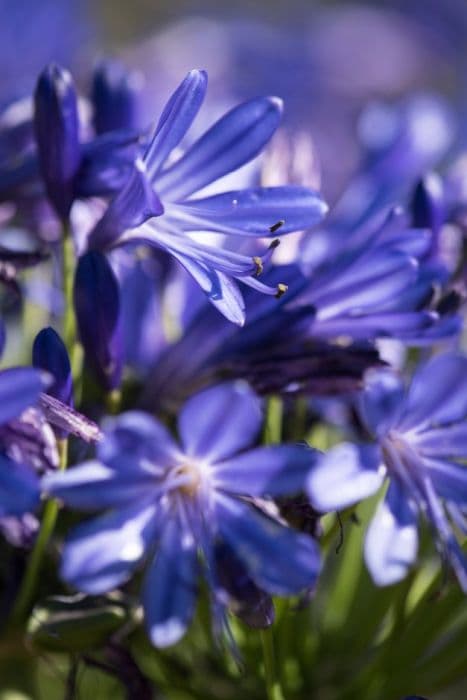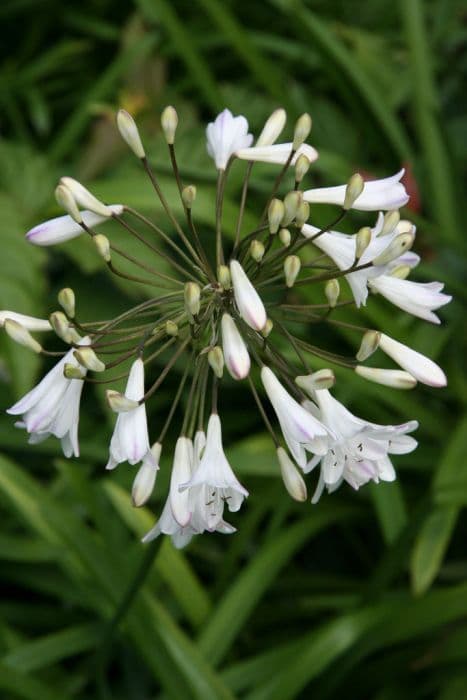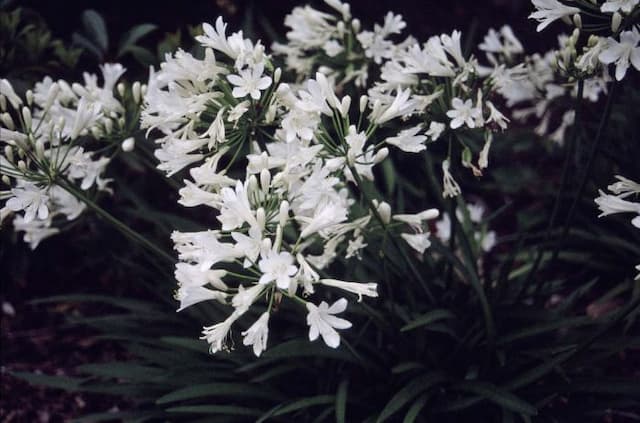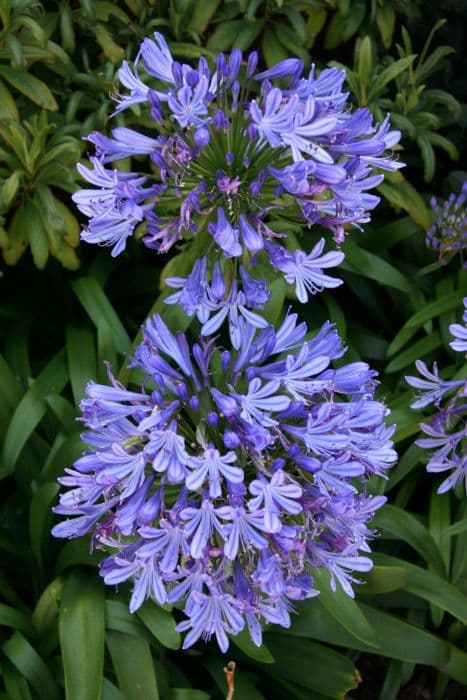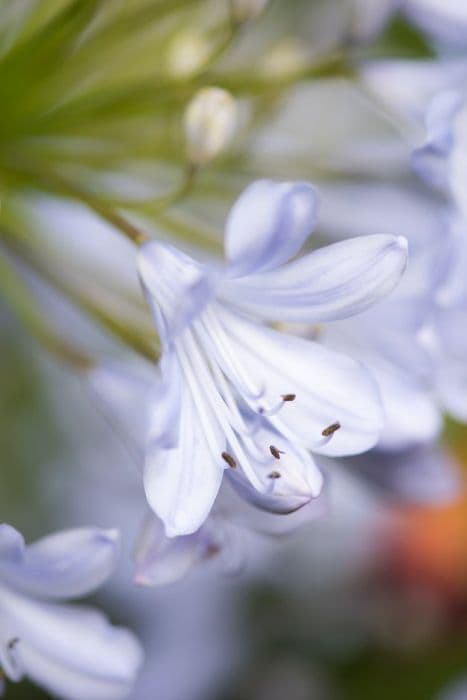African Lily Agapanthus 'Regal Beauty'

ABOUT
Agapanthus 'Regal Beauty' is a striking plant known for its lush foliage and showy flowers. It features clumps of long, arching, glossy green leaves that create a dense and grass-like appearance at the base. These leaves provide a beautiful backdrop for the flower stalks that shoot up and hold the blossoms above the foliage. The flowers of 'Regal Beauty' are particularly impressive, forming large, rounded clusters, known as umbels, composed of numerous trumpet-shaped individual blooms. Each flower exhibits a rich, deep blue to purple color, which can add a bold splash of color to any garden setting. These blossoms typically appear in abundance during the blooming season, creating an eye-catching display. The combination of the striking flowers and the elegant foliage allows Agapanthus 'Regal Beauty' to serve as a focal point in landscapes or as part of mixed borders, where its unique form and captivating colors can be fully appreciated.
About this plant
 Names
NamesFamily
Amaryllidaceae.
Synonyms
African Lily, Lily of the Nile, Love Flower.
Common names
Agapanthus 'Regal Beauty'.
 Toxicity
ToxicityTo humans
The Agapanthus, commonly known as Lily of the Nile, contains toxic substances that can cause harm if ingested. The entire plant is considered poisonous, including the leaves, stems, and especially the rhizomes. If any part of the Lily of the Nile is ingested by humans, symptoms of poisoning may include nausea, vomiting, and diarrhea. In some cases, skin contact with the sap can cause irritation or allergic reactions. It is important to handle this plant with care and ensure that it is not ingested, especially by small children who might be drawn to its flowers or leaves.
To pets
Lily of the Nile is toxic to pets, including cats and dogs. The plant contains compounds that can cause gastrointestinal upset and other clinical signs if ingested. Symptoms of poisoning in pets may include vomiting, diarrhea, drooling, anorexia, and abdominal pain. In severe cases, ingestion of the Lily of the Nile might lead to more serious symptoms such as tremors or heart problems. Pet owners should keep this plant out of reach of their animals and seek veterinary care immediately if they suspect their pet has consumed any part of the plant.
 Characteristics
CharacteristicsLife cycle
Perennials
Foliage type
Evergreen
Color of leaves
Green
Flower color
Blue
Height
3-4 feet [0.91-1.22 meters]
Spread
2-3 feet [0.61-0.91 meters]
Plant type
Herb
Hardiness zones
8
Native area
South Africa
Benefits
 General Benefits
General Benefits- Easy to Grow: Agapanthus 'Regal Beauty' is known for being hardy and easy to grow, requiring minimal care once established.
- Attracts Pollinators: This plant produces flowers that attract bees, butterflies, and other beneficial pollinators to your garden.
- Drought Tolerance: Once established, it can tolerate periods of drought, making it suitable for water-wise gardens.
- Showy Blooms: It features large balls of vibrant blue or purple flowers that bloom in the summer, adding visual interest to any garden.
- Long Blooming Season: Agapanthus has a lengthy blooming season which ensures a consistent and prolonged display of color.
- Border Plant: They make excellent border plants, providing a structured and elegant edge to garden beds or pathways.
- Pot Plant: Suitable for potting, Agapanthus can thrive in containers, making it versatile for balconies and patios.
- Low Maintenance: With little need for pruning or deadheading, it's a low-maintenance option for busy gardeners.
- Deer Resistant: Agapanthus is typically resistant to deer, which can be advantageous in areas where deer predation is a problem.
 Medical Properties
Medical PropertiesThis plant is not used for medical purposes.
 Air-purifying Qualities
Air-purifying QualitiesThis plant is not specifically known for air purifying qualities.
 Other Uses
Other Uses- As a dye plant: The blue or violet flowers of the Agapanthus can be used to create natural dyes for fabrics or inks.
- Floral art and design: Due to their striking blooms and long stalks, Agapanthus flowers are widely used in floral arrangements and decorative bouquets in art classes.
- Garden borders: Agapanthus 'Regal Beauty' is often planted in sequential rows to serve as attractive garden borders or edges because of their neat foliage and tall flowering stems.
- Poolside landscaping: Their ability to thrive in full sun makes them a perfect choice for poolside landscaping where they add a splash of color and tropical flair.
- Erosion control: Agapanthus has a robust root system which can be used on slopes or banks to help prevent soil erosion.
- Photography props: The bold blooms of the Agapanthus can be used by photographers as natural props in portrait and wedding photography for color and vibrancy.
- Insect habitat: Some species of moths and butterflies may use Agapanthus as a nectar source, aiding in the creation of a biodiverse garden habitat.
- Theme gardens: Agapanthus 'Regal Beauty' can be used in nautical-themed gardens because their globe-shaped flower heads resemble a collection of small sails or water splashes.
- Culinary decoration: Although they are not edible, the flowers of the Agapanthus can be used as a non-toxic garnish for culinary presentations.
- Plant competitions: Due to their stunning appearance when in full bloom, gardeners may grow Agapanthus 'Regal Beauty' for entry in horticultural shows and plant competitions.
Interesting Facts
 Feng Shui
Feng ShuiThe African Lily is not used in Feng Shui practice.
 Zodiac Sign Compitability
Zodiac Sign CompitabilityThe African Lily is not used in astrology practice.
 Plant Symbolism
Plant Symbolism- Love Letters: The genus name 'Agapanthus' is derived from the Greek words 'agape' meaning love, and 'anthos' meaning flower, symbolizing a message of love.
- Beauty: The name 'Regal Beauty' itself suggests a sense of majesty and outstanding beauty, emphasizing the plant's elegance.
- Fertility: Agapanthus is often associated with fertility due to its lush and bountiful flowering habit, as well as growing in rich, full clumps.
- Strength: The sturdy stalks of agapanthus that lead up to the striking flowers represent strength and resilience.
- Perseverance: Ability to thrive in various conditions denotes perseverance and adaptability.
 Water
WaterThe Lily of the Nile should be watered once the top inch of the soil starts to dry out to encourage deep root growth. During the growing season, this might mean watering approximately every week, but always check the soil moisture before watering. Apply water slowly and deeply, ensuring that the water reaches the root zone. One to two gallons per week should suffice, depending on the size of the plant and the environmental conditions. Reduce watering in the winter when the plant is dormant, but do not let the soil dry out completely.
 Light
LightLily of the Nile thrives best in full sun to partial shade. The ideal spot for this plant would be in an area where it receives at least six hours of sunlight daily. If grown indoors, place it near a south-facing window to ensure it gets adequate light. However, in extremely hot climates, some afternoon shade will help protect the plant from the intense heat.
 Temperature
TemperatureLily of the Nile prefers temperatures between 50 and 80 degrees Fahrenheit for optimal growth. It can survive minimum temperatures down to around 50 degrees Fahrenheit, but growth may be slowed. The maximum temperature should not exceed 90 degrees Fahrenheit for extended periods. Extreme temperatures, either cold or hot, can damage the plant or inhibit its growth, so it's important to place it in a location where it can receive moderate temperature conditions.
 Pruning
PruningPruning the Lily of the Nile is necessary to remove spent flower stalks and to encourage new growth. It should be pruned after flowering, typically in the late summer or fall. Cut the flower stems back to just above the base of the plant. Additionally, remove any damaged or yellowing leaves to maintain healthy growth and appearance. Pruning also helps to rejuvenate the plant for the following growing season.
 Cleaning
CleaningAs needed
 Soil
SoilAfrican Lilies prefer well-drained soil enriched with organic matter, such as compost or peat moss. A suitable soil mix is two parts loam, one part perlite or sand, and one part organic matter. The optimal soil pH for this plant is between 6.0 and 7.0.
 Repotting
RepottingAfrican Lilies should be repotted every 2 to 3 years or when the root system has outgrown the current container. Use fresh soil mix when repotting to refresh nutrients.
 Humidity & Misting
Humidity & MistingAfrican Lilies thrive in average room humidity levels. However, they can tolerate a wide range of humidity conditions as long as they have proper soil moisture and ventilation.
 Suitable locations
Suitable locationsIndoor
Place in bright, indirect light with good air circulation.
Outdoor
Plant in full sun to partial shade; shield from strong winds.
Hardiness zone
8-10 USDA
 Life cycle
Life cycleAgapanthus 'Regal Beauty', commonly known as the African Lily, begins its life cycle with seed germination, preferrably in warm temperatures, followed by the development of a small bulb and root system. After establishment, it enters a vegetative growth phase where foliage expands, forming strap-like leaves and the plant increases in size. Once mature, typically between spring and summer, it produces tall flowering stalks crowned with clusters of trumpet-shaped flowers. After blooming, the flowers give way to seed pods if pollination has occurred. Once the seeds mature, they can be dispersed to propagate new plants. Perennial in nature, the plant experiences a period of dormancy during colder months, with foliage dying back, and resuming growth in the following season.
 Propogation
PropogationPropogation time
Spring-Early Summer
Propogation: The most popular method of propagating the Agapanthus 'Regal Beauty', commonly known as the African Lily, is through division. This typically takes place in the spring or early summer. Gardeners will carefully unearth the clumps of the plant, ensuring they keep a generous amount of soil around the roots. Using a sharp knife or spade, they divide the clump into smaller sections, each with at least one or two growth points or shoots. These sections are then replanted at the same depth they were growing before, spaced about 12 to 18 inches (approximately 30 to 45 centimeters) apart to allow for adequate growth. The soil should be kept moist to help the newly planted divisions establish.
